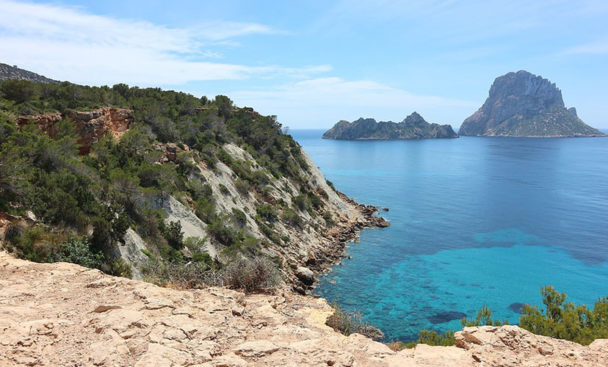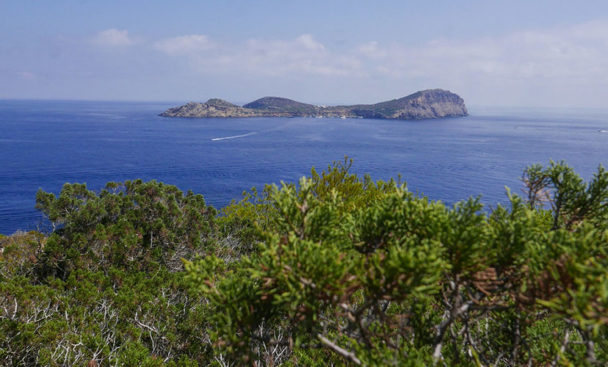Ibiza is surrounded by a total of 62 islets and some of these, given their location, size or special features are worthy of special mention. Some of these extensions of terra firma are steeped in history and legend or they are host to subspecies of lizards, unique in the world, in addition to other native flora and fauna that should be protected and celebrated. Other little islands belong to nature reserves and so visits are not allowed, but all of them add to the beauty of the Ibizan coastline and every summer they are the subject of thousands of photo opportunities and snapshots. This article takes a look at a few of these so that you can learn a little more about Ibiza’s geography.
Tagomago: this islet faces the town of Santa Eulària des Riu and is 1,525 metres long and 113 metres wide. It is a Special Protection Area for wild birds and has been classified as an EU Site of Community Importance. It is a mountainous little island with steep cliffs and isolated sandy coves. It has a lighthouse dating from 1913, a large house and a small port.
Ses Margalides: this small crop of islets to the north east of the island looks towards the steep coastline of Ses Balandres, near the village of Santa Agnès de Corona. They face an area of crags and steep inclines with tiny coves and numerous caves. The area is specially recommended for diving and watching out for fish such as the sphyrena species, better known as the barracuda, a predatory deep-sea fish known for its rapid form of attack.
Ses Bledes: this small archipelago owes its name to the plant that covers it and which resembles Swiss chard (“bledes” is the Catalan name for this vegetable) although the species is not edible. Their greatest treasure lies underwater as it is one of the main points for the passage of cetaceans in the Western Mediterranean. Of all the islands in the group, only four are covered in vegetation, although all are home to a subspecies of lizard that is endemic to the Pityusic Islands.
Es Vedrà and Es Vedranell: these are the best known of all the little islets that surround Ibiza. Almost 400 metres high and 2 kilometres from the coast, Es Vedra rises from the sea in front of Cala d’Hort and it is endlessly fascinating for visitors and residents alike. Many legends surround this large islet, from the belief that it is part of a Mediterranean Bermuda triangle, to the claims made for its magnetic radiation similar to the stones of Stonehenge, the Pyramids of Egypt and the Easter Island statues, or that unidentified flying objects can be seen from its peak, and other submarine phenomena in its waters. Tales and theories apart, it is a protected area owned by a group of 30 island families, although now the only population is a few goats, and it is the place where in the mid-19th century the Carmelite missionary Francisco Palau used to come to meditate. Es Vedrà and es Vedranell are also home to a sub species of a lizard commonly found on Ibiza, which is blue in colour, and also boasts unique flora. The islets are part of the Nature Reserve of Es Vedrà, Es Vedranell and the Poniente isles.
S’Espartar: this islet is also part of the nature reserve and is home to another bluish coloured lizard species, in addition to numerous birds, such as for example, the red- billed gull. Despite its arid and rocky terrain, esparto grass grows in abundance and is used to make ropes and twine for agricultural use, as well as basketry, hats and the traditional footwear of the Pityusic Islands known as “espardenyes”. During the summer, craftsmen obtain special authorisation to visit the island to collect the plant leaves and extract its fibres. Anyone who is a fan of diving will also love the area, as its rocky depths are home to octopus, moray eels and dentex.
S’illa des Bosc: This is the closest islet to Ibiza and dry land, and it is also the most inconspicuous member of the islands that form the Nature Reserve of Es Vedrà, es Vedranell and the Poniente isles. It rises 66 metres above the sea and its remarkable rocky formation beneath the water extends as far as Sa Conillera. Its name is taken from an ancient juniper wood that no longer exists.
Sa Conillera: this islet faces Punta d’en Rovira and can be seen from Platges de Comte. Sa Conillera is the largest of the little islands that surround Ibiza, covering 100 hectares with land rising to almost 70 metres in some places. It has a lighthouse built in 1859, the only one of its kind that was actually lived in, which provides a beacon for the passage between Ibiza and the Peninsula, and therefore it is extremely important to navigation in this area.
Sa Ferradura (Isla Murada): lies in the Bay of Sant Miquel de Balansat; covering 6 hectares it is the site of a large private mansion. In 2006 this island was listed as the most expensive island in the world by Forbes magazine, in the past it served as a refuge for pirates. It is joined to the island of Ibiza by a beach known as Es pas de s’Illa and is host to a lizard sub-species known as the “muradensis lizard”
S’illa de ses Rates: this island faces the beach of Ses Figueretes. Nowadays it is possible to take some magical photos from here, including the fireworks at Ibiza’s local fiestas, yet in the past it provided shelter to pirate ships while they waited for the ideal moment to attack.
Some of these small rock formations have been snapped in thousands of images and are famous throughout the world, although their names are not always known, as in the case of Cap Bernat ( a rock in the shape of a finger that faces the beach of Benirrás) or the island of Punta Grossa in the north of the island in front of an abandoned lighthouse. Another beautiful spot is the islet of s’Illot des Canaret, which is part of one of the most beautiful of the island’s hidden coves.

